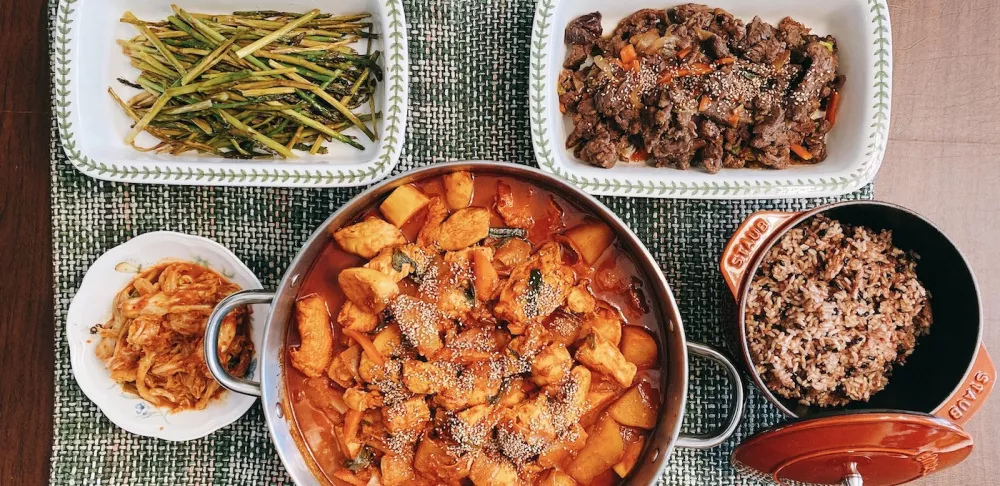Lunar New Year is celebrated with a variety of flavorful, unique foods in Asian culture. For Koreans, dduk-guk (rice cake soup) is a mainstay on the New Year’s table. I grew up eating this iconic dish every New Year’s Day, like many Korean Americans who observe the holiday on January 1 rather than on Lunar New Year, which lands sometime in late January or early February (this year, it starts on February 1).
Regardless of the date the New Year is celebrated, dduk-guk remains a traditional and comforting dish that Koreans around the world enjoy with loved ones. The rice cake soup is made with a base of either beef broth or anchovy broth, seasoned and boiled with flat, oval-shaped rice cakes that become soft and chewy in the soup. Sometimes dumplings are added to the mix, making it dduk-mandu-guk. Dduk-guk is usually topped with some combination of chopped green onions, strips of seaweed, thinly sliced fried egg and shredded beef (if beef broth is used). The soup is equal parts hearty, nourishing and satisfying: the perfect way to kick off a new year.
Dduk-guk, however, is just one of many ways that Koreans incorporate rice cakes into our cuisine. On the savory end of the spectrum, a well-known dish is tteokbokki (spicy stir-fried rice cakes). One of my favorite Korean comfort foods, tteokbokki consists of long, cylindrical rice cakes, fish cake strips (odeng), boiled eggs and vegetables like sliced onions, carrots and cabbage. The ingredients are cooked together in a spicy and slightly sweet gochujang-based sauce that can lean soupy or a bit thicker, depending on the recipe.
ICE alumni chefs in New York are readily showcasing rice cakes in their restaurants’ savory dishes, both in traditional applications and more avant-garde interpretations. Esther Choi (Culinary, ’11), chef and owner of mokbar in Chelsea and Brooklyn, gives tteokbokki a fresh twist by using brown buttered rice cakes, poaching the egg, and adding crispy pork and bacon and white kimchi to the spicy red sauce. Esther also offers a DIY budae jjigae, "army stew," meal kit that includes rice cakes alongside a host of other ingredients like spam, baked beans and Kurobuta sausage to be cooked in the kimchi pork ramen broth.
Sohui Kim (Culinary/Management, ’02) offers tteokbokki as well at her restaurant, Insa, in Brooklyn – dubbing it “OG street-style spicy rice cakes” and adding soft-boiled egg and puffed rice to the dish. Her take on tteok-mandu guk (rice cake and dumpling soup) is particularly fascinating, with chicken dumplings served in a smoked chicken dashi with rice cakes, egg and nori.
Departing from the savory side of things, sweet rice cakes are a world of their own, coming in a range of shapes, colors and fillings. They’re often part of celebrations, holidays and special occasions, like a baby’s 100th day or first birthday (both important milestones in Korean culture). Here's a small sampling of sweet rice cakes:
- Injeolmi are soft, sticky balls of rice cake dusted in a nutty, roasted soybean powder and made from steaming and pounding soaked sweet rice. Sometimes mugwort powder is added during the process to yield dark green-hued and earthy-tasting injeolmi.
- Mujigae-dduk, which translates to “rainbow rice cake,” is a rice cake with a slightly cakey texture made from short-grain rice flour. It is named such because three to five layers are dyed different colors; this rice cake often makes an appearance at events like weddings.
- Songpyun are small, chewy rice cake balls made from wet rice flour (short-grain rice flour), filled with a crushed sesame seed-honey/brown sugar mixture or a sweetened mungbean mixture (among other filling options) prior to steaming. Songpyun were originally steamed atop a pine needle layer, and are often seen in white, pink or green hues and commonly eaten during Chuseok (“Korean Thanksgiving” around the fall).
As you can see, there is a vast assortment of rice cakes in Korean cuisine, and depending on the application, they can be a casual snack, part of a meal, a dessert, gift or special occasion food (not to mention other cuisines that incorporate rice cakes into their cooking and snacking!). Because of the technique and effort required, people tend to buy frozen rice cakes or order from specialty rice cake bakeries rather than regularly make them at home. But whether as part of a weeknight dinner or a national holiday, and regardless of where you source them, it’s easy to see why rice cakes are so widely eaten and enjoyed in Korean culture: They’re extremely versatile, texturally interesting, and most of all, delicious in their many sweet and savory forms.
Read more about rice in Indian cuisine, and study global food traditions in Culinary Arts.




